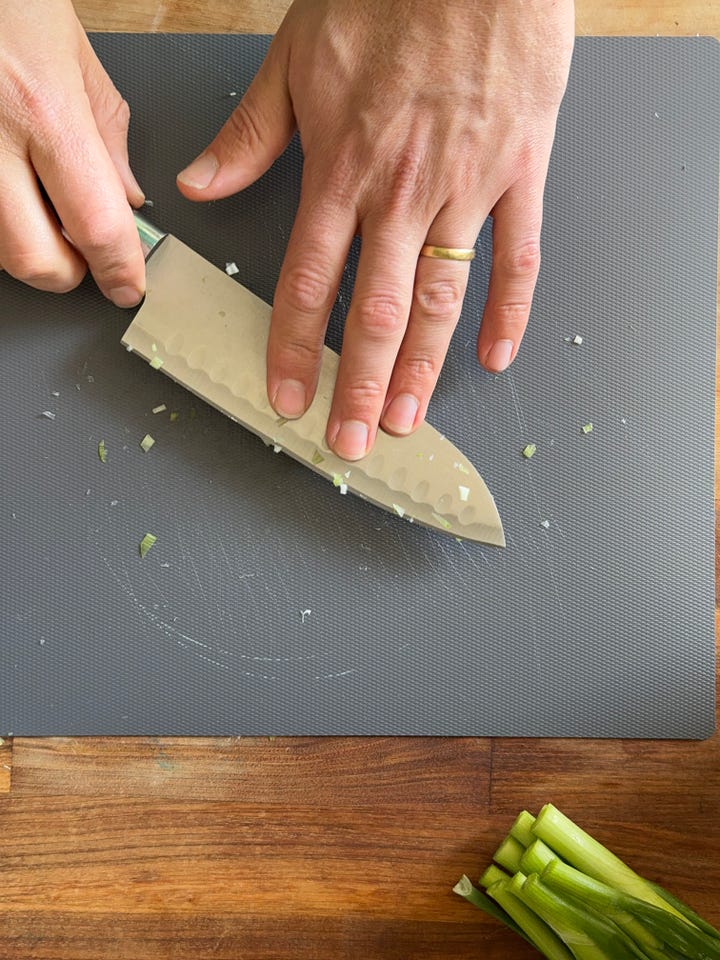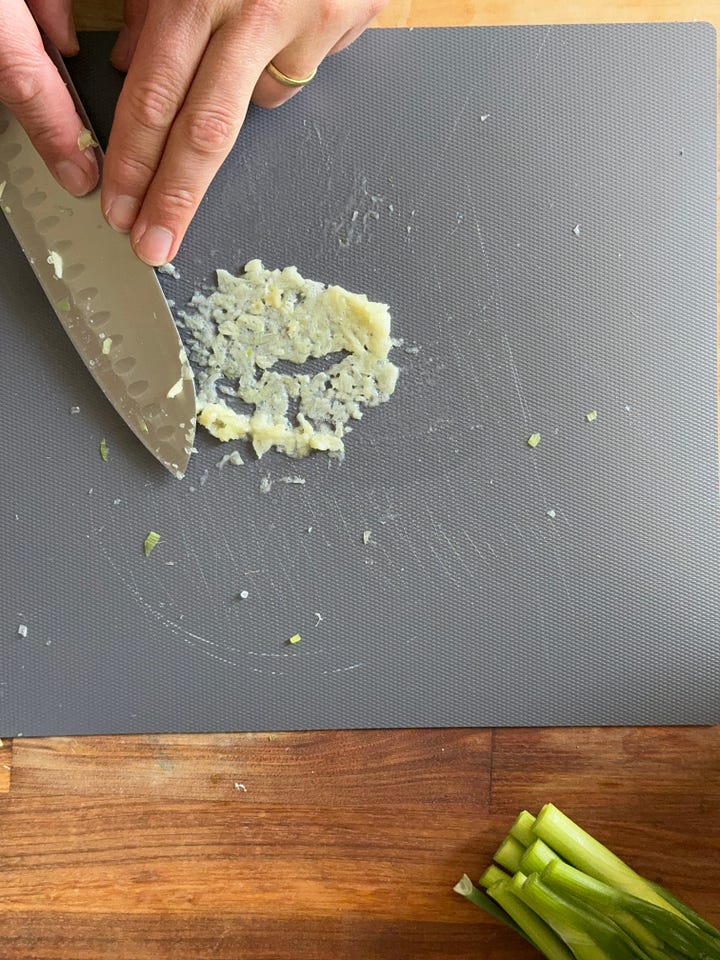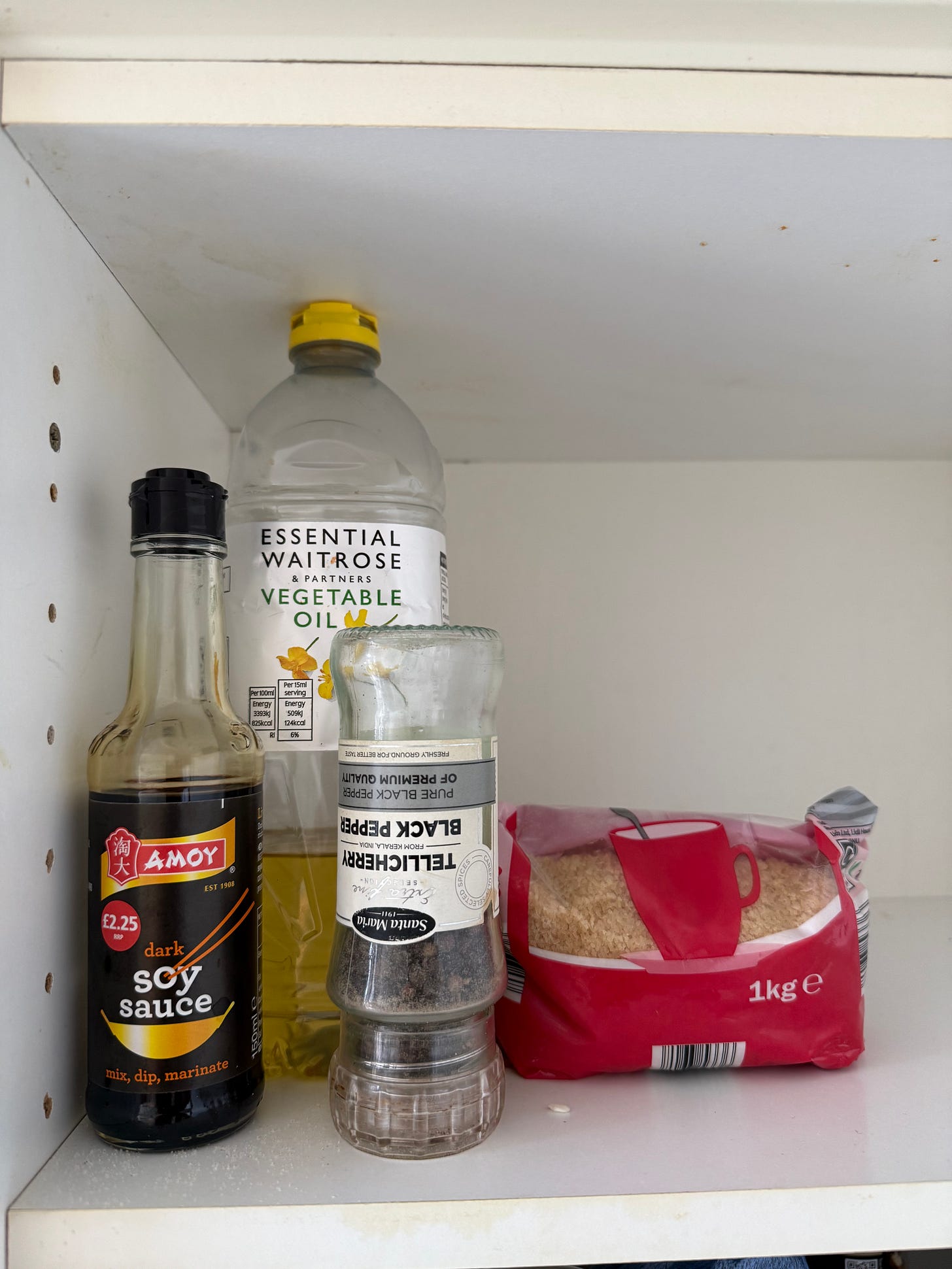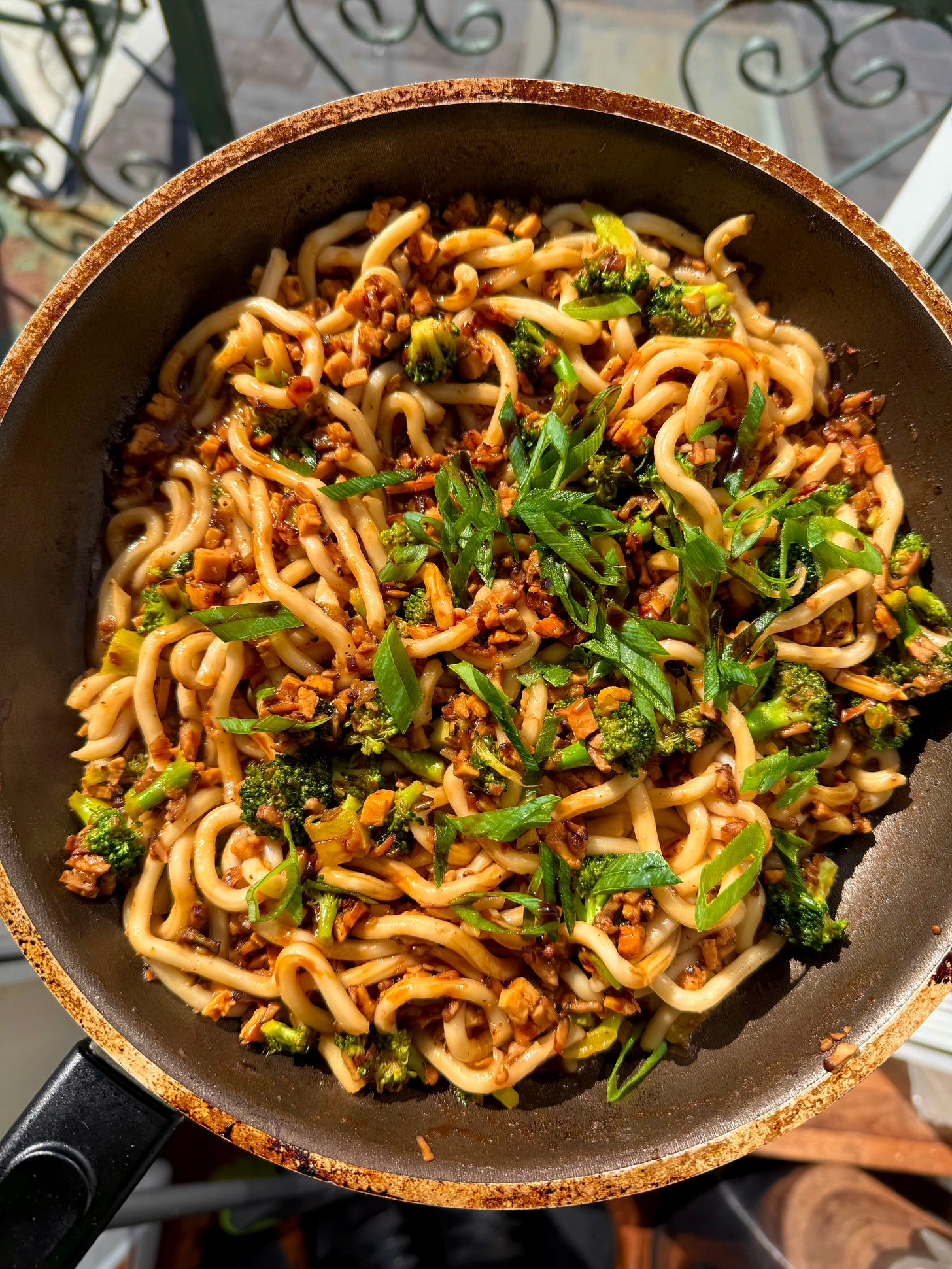The Five Star Noodles You Can Make In A Two Star Airbnb
How to cook a home-cooked meal when you’re away from home.
I’m out of town this week, and once again, I’ve found myself standing in a poorly equipped Airbnb kitchen, wondering what to cook.
Tummy growling, with little more than a worryingly wobbly frying pan and a knife that’s duller than my ex, the situation doesn’t look great. There aren’t many vegan restaurants nearby, and even if there were, seven days of restaurant meals in 2025 is enough to bankrupt me once and for all.
So, dear reader, I’m presented with the challenge of cooking something decent in a less than ideal setup. A challenge which, it turns out, has become the theme of this week’s newsletter. My home-cooked dinner needs to be delicious (obvs), balanced (meh, somewhat) and achievable with limited equipment and minimal ingredients. I’m jumping through hoops here huns!
To be clear, I’m not actually staying in an Air BnB (don’t worry - the boycott continues) but my temporary kitchen setup is similarly… shall we say…sparse. So, how do you prepare a home-cooked meal when you’re away from home? At the bottom of this newsletter I’m going to share the recipe I improvised and ended up having for dinner (Black Pepper Mushroom & Tempeh Udon) but I’m also going to show you the three steps I followed to come up with it. These steps are designed to help you whip up a delicious meal, no-matter what your holiday rental throws at you.
Before I start though, two quick updates:
Only a handful of tickets left for my Getaway Co trip to Bali - it’s a fully vegan vacation with a bunch of other incredible travellers (including me). We’ll swim in waterfalls, hike up volcanoes, visit rice fields and I’ll even host an exclusive vegan cooking workshop for you. It’s from 20th-30th September and you can find full details and tickets here.
If you’ve already been on a Getaway Co trip OR you’re on the fence about attending a future one, I’m going to be at the big Getaway Co get-together in Toronto on May 9th. We did one of these in LA last year and it was SO fun! Just a great chance to meet other vegans who love travelling and also ask us any questions about future trips. The gorgina Lauren Toyota (Hot For Food) and Erin Ireland (To Live For) will also be there!
OK! On with the show!
How to cook a home-cooked meal when you’re away from home.
Step 1: Check Your Inventory
This is our first significant limitation, so let’s start here. What do we actually have in the kitchen?? It’s essential to check this out before heading out to buy any ingredients because you don’t want to buy a bunch of canned goods before realising you don’t have a can opener…
In my case, here’s everything I DID have access to:
The aforementioned frying pan (let’s call her Sandra)
The aforementioned kitchen knife (let’s call him Edward)
A wooden spoon (let’s call them Bailey)
A stove and a fridge (thank goodness and also Oprah)
An operational kettle
A crippling “Good-Boy” complex
Ok, now let’s look at what I DIDN’T have access to:
Tupperware, so no leftovers
Store-cupboard ingredients, besides vegetable oil, salt, pepper, sugar and a small bottle of dark soy sauce
A trustworthy oven (she might work just fine, but in the words of Mariah Carey, I don’t know her)
So from this setup, I knew that I needed a one-pot, stove-top recipe with a carb that didn’t require boiling (coz no saucepan), so no pasta or rice dishes. Not too much chopping (Edward can’t handle it) and the recipe couldn’t rely on blending or grating anything. At this point, you should be able to eliminate a few types of dish (no soups and definitely no traybakes), and hopefully you’ve begun to imagine which kind of recipe might actually work in your temporary kitchen.
Step 2: Select Your Ingredients
So now that we know what we’re working with, equipment-wise, we need to move onto our actual ingredients. I’m going to assume that you have access to at least a basic grocery store but that anything esoteric or unusual is off the list.
It’s essential to build your recipe around the store-cupboard ingredients that you do have access to, to make sure you don’t end up buying a bunch of stuff just to leave it in the cupboard when you check out. For any ingredients you do need to buy, focus on small but mighty flavour bombs, to avoid waste. Here’s everything I had in the store-cupboard (presumably left by previous guests):
Here’s the thought process behind my ingredient run that led to my noodles:
I had no spices, so anything curry adjacent was out. However, I had black pepper, so this became the dominant spice of my dish.
I had dark soy sauce, and my favourite way to use this ingredient is in my Vegan Yaki Udon recipe - so you see where I’m going?
Udon noodles are great too because they don’t require pre-boiling and they are sold in single servings, so again, less waste than buying a whole bag of pasta or dried noodles.
For protein, my mind went straight to tempeh, because it tends to come in smaller packets than tofu and packs more flavour and protein into each gram.
I chose spring onions over a bag of regular ones, because I could use the whole bunch in one recipe. And for other veggies I chose garlic, broccoli and shiitake mushrooms because big flavour and big nutrition.
And speaking of flavour, I picked up a tiny jar of white miso paste (not pictured) because it improves everything and whatever’s left after this meal I’ll spread on my toast in the morning.
So, this is what I ended up buying at the store:
Udon noodles, tempeh, garlic, shiitake mushrooms, broccoli and spring onions. I also got a small jar of miso, but forgot to include this in the photo.
Step 3: Work Within Your Means
Now to actually start cooking. Because we did our inventory check earlier, this should be a breeze, but there are still a few tricks that can help when cooking with limited kit.
Firstly, if following a recipe and you have no measuring spoons, keep in mind that a dessert spoon is roughly equal to a tablespoon, and teaspoons are generally pretty accurate, so use cutlery for measuring. Alternatively, remember that:
1 teaspoon ≈ the tip of your index finger (from knuckle to tip)
1 tablespoon ≈ the size of your thumb (from knuckle to tip)
If you’re planning to use crushed garlic in your recipe and you find yourself without a garlic press or grater, here’s the best way to crush garlic into a paste using just a knife and some salt:




Start by peeling and placing the clove on your chopping board. Use the flat side of you knife to crush the clove roughly, pushing down with your fist until you feel it squish.
Sprinkle the clove with a little salt (flaky or rock salt works best here because it’s more abrasive) then use the flat side of your knife to crush the salt into the clove.
Now drag the flat of the knife along the chopping board, squishing the garlic as you go.
Push the crushed garlic back into one spot and repeat the process again and again until the garlic is a smooth paste. It’s now ready to use in your recipe.
And that’s it, you should be ready to cook! These aren’t stone-set rules, but they’re a framework that should help you free-style in this very specific scenario. What are your rules for cooking in an Airbnb? Put them in the comments so I can update my method!
OK, Thanks for reading. Your recipe is below!
If you had fun with this one, consider upgrading to a paid subscription. Paid subs are the only reason this newsletter is still going, so I genuinely couldn’t do this without you!
Black Pepper Mushroom & Tempeh Udon
Ingredients
2 x 150g (5.3 oz) packs of vacuum packed udon noodles
1 tbsp vegetable oil
1 tsp ground black pepper
1 bunch spring onions, finely chopped, greens and whites separated
3 cloves garlic, crushed
150g (5.3 oz) mushrooms, roughly chopped or grated
100g (3.5 oz) tempeh, finely chopped or grated
Half a head of broccoli, cut or broken into very small florets
3 tbsp dark soy sauce
1 tsp sugar
1 tbsp lemon juice, or white wine/rice/apple cider vinegar
6 tbsp water (90 ml)
1 stock cube, crumbled, or 1 tsp vegan bouillon powder or 2 tsp miso paste
Method
Place the udon noodles in a large heatproof bowl and cover with freshly boiled water from a kettle. Set aside to soak while you prepare the rest of the dish.
Heat the vegetable oil in a large frying pan or wok over medium heat. Add the ground black pepper and let it sizzle for a few seconds to infuse the oil.
Add the white parts of the spring onions and the garlic. Fry for 1 minute until fragrant.
Add the mushrooms and tempeh. Cook for 5–6 minutes, stirring often, until any liquid from the mushrooms has evaporated and the mixture is starting to brown.
Add the broccoli and stir-fry for 2–3 minutes until it starts to soften but still has bite.
In a small bowl or jug, combine the dark soy sauce, sugar, lemon juice (or vinegar), water and stock cube or bouillon/miso. Stir to dissolve.
Pour the sauce into the pan and bring to a simmer.
Drain the udon noodles and add them to the pan. Toss to coat well in the sauce and cook for a final 1–2 minutes, stirring until everything is glossy and well combined.
Serve hot, scattered with the green parts of the spring onions and extra black pepper.








Thanks for sharing the journey. You not only shared a great recipe (yum) but by sharing your thought process, you allowed me to think differently (small quantity green onions, oh yeah). I can apply the approach (simple, one serving) to other recipe ideas. Thank you!
I've had an almost identical experience with the blunt knife and no less than five frying pans in a rental.
I used a packet of Chinese spiced microwave rice, marinated tofu and green beans to make a similar dish and was so proud of my ingenuity!